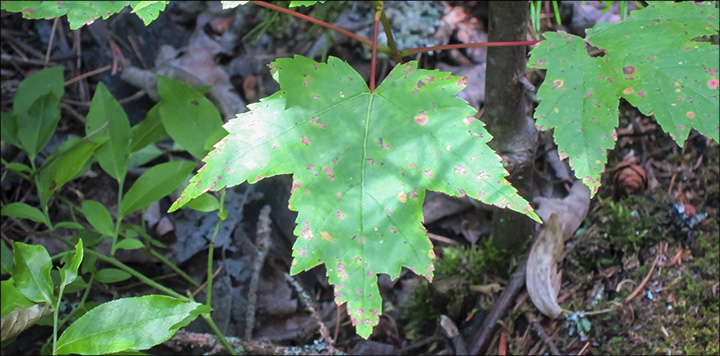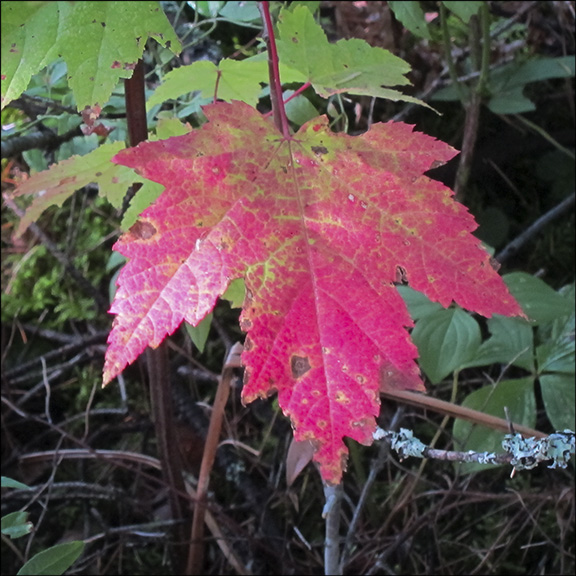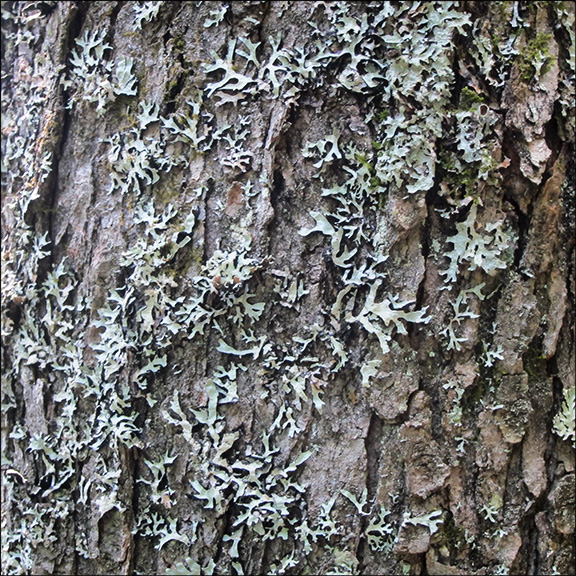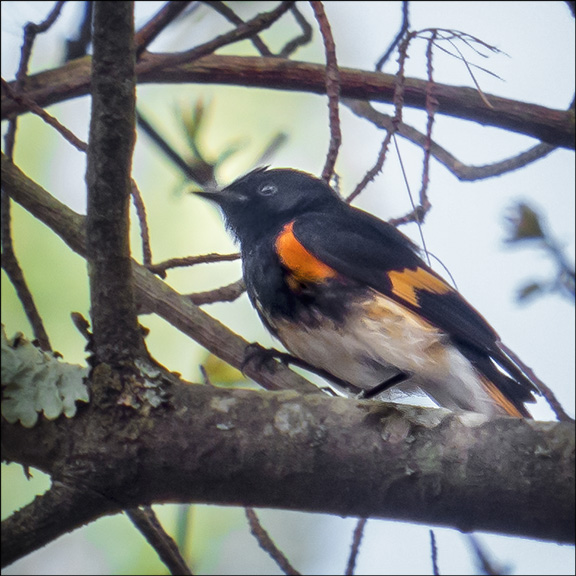Trees of the Adirondacks:
Red Maple (Acer rubrum)
 Trees of the Adirondacks: The leaves of the Red Maple are coarsely toothed. Red Maple on the Barnum Brook Trail (21 July 2012)
Trees of the Adirondacks: The leaves of the Red Maple are coarsely toothed. Red Maple on the Barnum Brook Trail (21 July 2012)
| This page is no longer being updated. For an updated and expanded version of this material, see: Red Maple (Acer rubrum). |
The Red Maple (Acer rubrum) is a medium to large deciduous tree that flourishes in a variety of habitats in the Adirondack Mountains. Its common name reflects the fact that its flowers, fruits, leaf stalks, and autumn colors are red or reddish. It is also known as Scarlet Maple, Swamp Maple, Soft Maple, Carolina Red Maple, and Water Maple. The Red Maple is the state tree of Rhode Island.

Identification of the Red Maple: Like other maples, the branches of Red Maples are opposite; and they have opposite, lobed leaves. Red Maple leaves generally have three major lobes, sometimes with two additional smaller lobes near the base of the leaf. The tips of the lobes are narrowly pointed. The notches or dips between the lobes are V-shaped. The margins of the leaf have coarse teeth. The leaves are dull green and smooth above, lighter green or silvery beneath and more or less hairy. The twigs and buds are reddish. The bark of a young Red Maple is light gray, smooth, and thin; older trees develop furrowed bark with scaly or even shaggy ridges. Red Maple trees have an erect, single trunk.
Keys to identifying the Red Maple and differentiating it from other maples include its leaves, bark, growth habit, and habitat.
- The leaves of the Sugar Maple and the Red Maple have a similar shape. However, Red Maple leaves are coarsely toothed. The Sugar Maple, by contrast, has just a few pointed tips on each lobe. Also, the dips between the lobes of the Red Maple are pointy, forming a sharp "v," while those between the lobes of the Sugar Maple are u-shaped.
- Although Red Maple, Striped Maple, and Mountain Maple all have toothed leaf margins, the shape of Red Maple leaves is different from those of the Striped Maple and Mountain Maple. Red Maple leaves are more deeply lobed than those of the Striped Maple and Mountain Maple.
- The bark of the Red Maple contrasts with that of the Striped Maple, which is marked with distinctive stripes.
- The growth habit of the Red Maple is similar to that of the Sugar Maple, but contrasts with that of both the Striped Maple and the Mountain Maple. Both of these latter species are much smaller. The Striped Maple is a small tree or large shrub, often divided into several branches from near the base, while the Mountain Maple is a bushy shrub.
- Habitat is another clue distinguishing the Red Maple from the Sugar Maple. Red Maple trees are more tolerant of wet soil. A large, single-trunked maple tree growing near a marsh or other wetland is more likely to be a Red Maple.

The Red Maple is one of the first trees to flower in the spring, generally several weeks before the leaves appear. The flowers are small, with slender stalks, pink to red. Flowering occurs on all branches in the well-lit upper portion of the crown. This species is one of the early harbingers of autumn as it turns color well in advance of other eastern deciduous trees, especially when it is located in wet sites. The fiery colors of fall are typically a brilliant red. The winged seeds (samaras) of the Red Maple are the smallest of all native maples, about 5/8-3/4 inches long. The samaras ripen in the spring.
Uses of the Red Maple: The wood of the Red Maple is not particularly desirable for lumber or veneer. Red Maple is known in the lumber industry as soft maple. The wood is close grained and resembles that of the Sugar Maple, but is softer in texture and has somewhat poorer machining qualities. The Red Maple is a popular landscaping tree for its brilliant fall foliage, smoky red male flowers in spring, and red samaras on female trees.
The Red Maple was used by various native American tribes to make spoons, arrow heads, baskets, and bowls. Leaves of the Red Maple were frequently used in the Ojibwe bead work designs. Native Americans also used the sap to make sugar and syrup. The Iroquois dried, pounded, and sifted the bark to make into bread. The plant was also used for medicinal purposes. For instance, the Cherokee used an infusion for hives and boiled the inner bark with water as an eyewash. Pioneers reportedly made ink and cinnamon-brown and black dyes from a bark extract.

Wildlife Value of the Red Maple: Red Maple leaves, twig, bark, and fruits provide a food source for numerous mammals, birds, and insects. However, Red Maple leaves are extremely toxic to horses and cattle. The species is not preferred by deer as a browse source, so in areas with heavy deer pressure this species is over-abundant in forest regeneration. The Red Maple is a larval host for the Rosy Maple Moth. Red squirrels use the cavities of older trees as nesting habitat.
A number of birds build nests in Red Maples, including American Redstarts, Black-backed Woodpeckers, and Downy Woodpeckers. Woodpeckers and other insectivorous songbirds often search for the many insects that feed on maples; these insects are especially important in feeding young nestlings. For instance, Red Maple stands are a preferred micro-habitat for foraging for Red-eyed Vireo. Bird species which breed in Red Maple habitat include:
| Purple Finch | Veery |
| Yellow-bellied Sapsucker | Wood Thrush |
| Hooded Warbler | Eastern Wood-Pewee |
| Northern Parula | Canada Warbler |
| Alder Flycatcher |
Distribution of the Red Maple: Red Maple is one of the most abundant and widespread trees in eastern North America, occurring in a diverse array of ecological conditions. It grows from southern Newfoundland, Nova Scotia, and southern Quebec to southern and southwestern Ontario, extreme southeastern Manitoba, and northern Minnesota; south to Wisconsin, Illinois, Missouri, eastern Oklahoma, and eastern Texas; and east to Florida. The Red Maple is most common in New England, the Middle Atlantic States, upper Michigan, and northeast Wisconsin. It is rare farther west and south.
The Red Maple is very well adapted to most soil and site conditions. The species may be found on diverse sites, from dry ridges and southwest slopes to peat bogs and swamps. It commonly grows under the more extreme soil-moisture conditions, either very wet or quite dry. It is common in mountainous country on the drier ridges and on south and west exposures of upper slopes. It is also common, however, in swampy areas, on slow-draining flats and depressions, and along small sluggish streams. In the extreme south, the Red Maple is almost exclusively a swamp species.
Red Maples at the Paul Smiths VIC: In contrast to Black Spruce and Tamarack, the Red Maple does not grow in the VIC's wetland areas, such as Heron Marsh and Barnum Bog. However, Red Maples are quite tolerant of moist soils and can commonly be found on the margins of Heron Marsh. Red Maples may be seen on the Heron Marsh Trail, specifically the first half-mile of the trail from the VIC Building to the floating bridge. Red Maple are also visible from Shingle Mill Falls, on the Logger's Loop Trail. Probably the most convenient place to observe the Red Maple is on the Barnum Brook Trail This species is one of the eleven tree species marked with signage along this trail, providing an easy way to learn to differentiate the Red Maple from the Sugar Maple and Striped Maple, which are also identified on the trail.
References
- United States Department of Agriculture. Forest Service. Silvics of North America. Red Maple. Retrieved 25 January 2015.
- United States Department of Agriculture. Plants Database. Retrieved 25 January 2015.
- Lady Bird Johnson Wildflower Center. Native Plant Database. Retrieved 25 January 2015.
- University of Wisconsin. Trees of Wisconsin. Acer rubrum. Retrieved 25 January 2015.
- Online Encyclopedia of Life. Acer rubrum. Retrieved 25 January 2015.
- University of Wisconsin. Robert W. Freckmann Herbarium. Retrieved 25 January 2015.
- New York Flora Association. New York Flora Atlas. Retrieved 25 January 2015.
- University of Michigan. Native American Ethnobotany. A Database of Foods, Drugs, Dyes and Fibers of Native American Peoples, Derived from Plants. Retrieved 25 January 2015.
- Plants for a Future. Database. Retrieved 25 January 2015.
- The Birds of North America. Purple Finch, Yellow-bellied Sapsucker, Alder Flycatcher, American Redstart, Veery, Hooded Warbler, Wood Thrush, Northern Parula, Red-eyed Vireo, Eastern Wood-Pewee, Canada Warbler, Black-backed Woodpecker, and Downy Woodpecker. Subscription Web Site. Retrieved 26 January 2015.
- Trees of the Northern Forest Trail Walk
- Ellen Rathbone, "Adirondack Tree Identification 101," The Adirondack Almanack, 18 November 2009. Retrieved 24 January 2015.
- Paul Smith’s College VIC. Barnum Brook Tree Game.
- Michael Wojtech. Bark: A Field Guide to Trees of the Northeast (UPNE, 2011).
- George A. Petrides. A Field Guide to Eastern Trees (Boston: Houghton Mifflin Company, 1998), pp. 54-55, 203-204.
- George A. Petrides. A Field Guide to Trees and Shrubs (Boston: Houghton Mifflin Company, 1958,1972), pp. 7, 96-97, 120-121.
- Gil Nelson, Christopher J. Earle, and Richard Spellenberg. Trees of Eastern North America (Princeton : Princeton University Press), pp. 624-625.
- C. Frank Brockman. Trees of North America (New York: St. Martin's Press), pp. 212-213.
- Keith Rushforth and Charles Hollis. Field Guide to the Trees of North America (Washington, D.C., National Geographic, 2006), p. 202.
- National Audubon Society. Field Guide to North American Trees (New York: Alfred A. Knopf, 1980), Plates 261, 366, 369, 495, 593, pp. 577-578.
- Allen J. Coombes. Trees (New York: Dorling Kindersley, Inc., 1992), p. 100.
